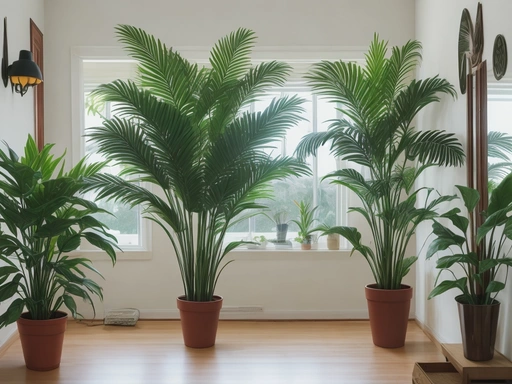Watering Schedule For Parlor Palm: The Complete Guide
Key Takeaways:
- Water Parlor palm once every 7-10 days.
- Allow the top 1-2 inches of soil to dry between waterings.
- Adjust watering frequency based on the humidity levels in your home.
- Use distilled water or collect rainwater for optimal growth.
Are you struggling to keep your Parlor palm thriving? The secret lies in establishing a proper watering schedule.
As an avid plant lover, I know firsthand the importance of providing the right amount of water to this delicate indoor plant.
In this article, I will guide you through the process of creating an effective watering schedule for your Parlor palm. We’ll discuss factors to consider, such as soil moisture levels and environmental conditions, and explore the best practices for watering your plant.
Say goodbye to overwatering or underwatering your Parlor palm and say hello to healthy, vibrant foliage.
Let’s dive in!
| Time | Watering Frequency |
|---|---|
| Middle of winter | Once every 2-3 weeks |
| Spring and Fall | Every 7-10 days |
| Summer | Every 5-7 days |
Importance of a watering schedule for Parlor palm
Having a watering schedule for your Parlor palm is important for ensuring its health and well-being.
Understanding the Parlor palm’s watering needs
The Parlor palm requires consistent and thorough watering to thrive. It prefers moist soil but doesn’t like to sit in waterlogged conditions.
Check the top inch of soil regularly and water when it feels dry.
Adjust watering frequency based on the season and environmental conditions. Avoid overwatering or underwatering, as both can harm the plant.
Using filtered or distilled water can benefit the Parlor palm’s health.
Pay attention to the plant’s response and adjust your watering routine accordingly.
The role of a consistent watering schedule in maintaining the health of the Parlor palm
A consistent watering schedule is crucial for maintaining the health of a Parlor palm. It helps provide the right amount of moisture for the plant’s growth and prevents issues like overwatering or underwatering.
A well-maintained watering schedule ensures that the Parlor palm receives adequate hydration, allowing it to thrive and stay healthy.

Factors to consider when creating a watering schedule for Parlor palm
To create a watering schedule for your Parlor palm, consider assessing the soil moisture levels and evaluating the environmental conditions. Additionally, take into account the size and maturity of your plant.
Assessing the soil moisture levels
To assess the soil moisture levels for your Parlor palm, simply stick your finger about an inch into the soil. If it feels dry, it’s time to water.
If it feels moist, hold off on watering.
Repeat this process regularly to maintain the right moisture balance.

Evaluating the environmental conditions
To evaluate the environmental conditions for your Parlor palm, consider the temperature, humidity, and light levels in the plant’s location. Place the plant in an area with indirect sunlight, maintain a temperature between 65-80°F (18-27°C), and provide moderate humidity.
Avoid exposing the plant to drafts or extreme temperature fluctuations.
Taking into account the size and maturity of the Parlor palm
Consider the size and maturity of your Parlor palm when creating a watering schedule.
Smaller, younger plants will require less water compared to larger, more established ones.
Adjust the frequency and amount of water accordingly to promote healthy growth and avoid issues like overwatering or underwatering.
Creating a watering schedule for Parlor palm
Creating a watering schedule for your Parlor palm is essential for its health and growth.
Determining the frequency of watering
To determine the frequency of watering for your Parlor palm, you need to consider factors like soil moisture levels, environmental conditions, and plant size and maturity. Assess the soil moisture with a finger test, evaluate the humidity and temperature of the surroundings, and adjust the watering schedule accordingly.
Establishing the amount of water to be used
To establish the amount of water to be used for your Parlor palm, you need to consider a few factors. First, check the moisture levels in the soil to determine if watering is needed.
Use your finger or a moisture meter to assess this.
Next, take into account the environmental conditions, such as temperature and humidity, as they can affect the plant’s water requirements. Lastly, consider the size and maturity of your Parlor palm, as larger and more established plants generally require more water.
By considering these factors, you can create an effective watering schedule for your Parlor palm.

Adjusting the watering schedule based on seasonal changes
Adjusting the watering schedule for your Parlor palm based on seasonal changes is important to ensure its health. During the warmer months, increase watering frequency as the plant will need more moisture.
In colder months, reduce watering as the plant’s growth slows down.
Check the soil moisture regularly and adjust accordingly.
Watering techniques for Parlor palm
To properly water your Parlor palm, water thoroughly and then allow the soil to slightly dry out before watering again.
Best practices for watering Parlor palm
To ensure the proper watering of your Parlor palm, here are some best practices to keep in mind:
- Water thoroughly: When watering, make sure that the water fully saturates the soil.
- Allow for proper drainage: Ensure that your pot has drainage holes to prevent waterlogging.
- Check soil moisture: Before watering again, check the moisture level of the soil using your finger or a moisture meter.
- Adjust watering frequency: The frequency of watering will depend on factors like humidity, temperature, and the size of your plant.
- Avoid overwatering: Only water when the top inch of soil is dry to the touch.
- Use filtered or distilled water: Consider using filtered or distilled water to avoid harmful substances from tap water.
- Observe and adjust: Keep an eye on your plant’s condition and adjust your watering schedule as needed.
Methods to avoid overwatering or underwatering
To avoid overwatering or underwatering your Parlor palm, you need to have a good understanding of its watering needs.
Here are some methods to help you achieve the right balance:
- Check the soil moisture regularly: Stick your finger about an inch deep into the soil. If it feels dry, it’s time to water. If it’s still moist, hold off on watering.
- Use well-draining soil: Parlor palms prefer soil that drains well to prevent waterlogging. Ensure your pot has drainage holes, and use a mix of potting soil and perlite or sand for better drainage.
- Water in moderation: When it’s time to water, give your Parlor palm a thorough soaking, ensuring water reaches the roots. Allow the excess water to drain away. Avoid watering too frequently, as this can lead to root rot.
- Adjust watering based on the environment: Take into account factors such as temperature, humidity, and light levels. Your Parlor palm may require more frequent watering during hot, dry periods, but less during cooler months.
- Observe your plant: Pay attention to the appearance of your Parlor palm. If the leaves start to turn yellow or droop, it could be a sign of overwatering. If the leaves become dry and crispy, it may be underwatered. Adjust your watering accordingly.
The benefits of using filtered or distilled water for Parlor palm
Using filtered or distilled water for your Parlor palm can have several benefits. Firstly, it helps to remove impurities and chemicals that may be present in tap water.
This ensures that your plant receives clean and pure water, which can promote better growth and overall health.
Additionally, filtered or distilled water has a balanced pH level, which is important for maintaining optimal soil conditions for your Parlor palm. It can also help to prevent mineral buildup in the soil, which can be harmful to the plant.
Overall, using filtered or distilled water is a simple yet effective way to provide the best hydration for your Parlor palm.
Signs of overwatering and underwatering in Parlor palm
Is your Parlor palm showing signs of overwatering or underwatering?
Learn how to identify these issues and how to remedy them.
Identifying symptoms of overwatering
Some symptoms of overwatering in Parlor palm include yellowing and wilting leaves, mushy or rotten roots, and a foul odor coming from the soil. Additionally, the plant may show signs of stunted growth and the soil may feel constantly damp or waterlogged.
Recognizing signs of underwatering
Recognizing signs of underwatering is important for the health of your Parlor palm.
Look out for dry and wilted leaves, yellowing or browning of the foliage, slow growth, and soil that feels dry to the touch.
These are all indicators that your plant needs more water.
How to remedy overwatering or underwatering issues
To remedy overwatering, allow the soil to dry out by reducing the frequency of watering. Ensure proper drainage and avoid using pots without drainage holes.
For underwatering, increase watering frequency and check soil moisture regularly.
Be sure to water thoroughly to ensure proper hydration.
Frequently Asked Questions about watering Parlor palm
How often should I water my Parlor palm?
Water your Parlor palm when the top inch of soil feels dry. Stick your finger into the soil to check.
Typically, this means watering every 1-2 weeks.
Adjust frequency based on environmental factors like temperature and humidity. Remember, it’s better to underwater than overwater a Parlor palm.
What happens if I overwater my Parlor palm?
If you overwater your Parlor palm, the roots can become waterlogged and start to rot. This can lead to root damage, yellowing or wilting leaves, and eventually, the death of the plant.
Overwatering can also create a favorable environment for pests and fungal diseases to thrive.
Can I use tap water to water my Parlor palm?
Yes, you can use tap water to water your Parlor palm, but it’s important to note that tap water may contain chemicals like chlorine or fluoride that can be harmful to the plant. To minimize any potential damage, it’s recommended to let the tap water sit for 24 hours before using it or use filtered or distilled water instead.
How can I tell if my Parlor palm is getting enough water?
To determine if your Parlor palm is getting enough water, you can check the moisture level of the soil. Stick your finger about an inch deep into the soil, and if it feels dry, it’s time to water.
Also, look for signs of underwatering such as yellowing leaves or wilting.
Final Verdict
Creating and maintaining a consistent watering schedule is essential for the health and well-being of your Parlor palm.
By understanding the plant’s watering needs, assessing soil moisture levels, evaluating environmental conditions, and considering the plant’s size and maturity, you can establish an effective watering regimen.
Implementing best practices, avoiding overwatering or underwatering, and using filtered or distilled water can further optimize the plant’s growth.
Being aware of signs of overwatering and underwatering and taking corrective measures promptly can prevent damage to the Parlor palm.
By following these guidelines, you can ensure that your Parlor palm thrives and adds beauty to your indoor space.







